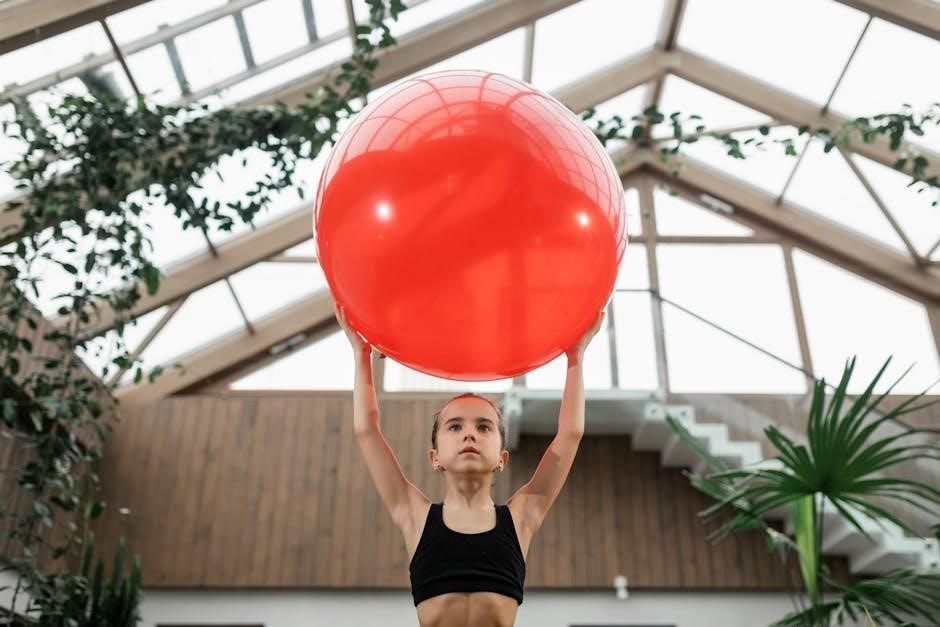brain gym activities pdf
Brain Gym activities are a set of 26 simple movements designed to enhance learning by engaging both brain hemispheres․ Created by Paul Dennison, these exercises improve focus, coordination, and memory․ They are widely used in educational and therapeutic settings to boost cognitive function and overall well-being․ Available in PDF guides, Brain Gym offers a structured approach to improving learning skills for students, educators, and therapists alike․
Definition and Purpose of Brain Gym
Brain Gym is a collection of 26 simple, yet effective movements designed to enhance learning and cognitive function․ Created by Paul Dennison, these exercises aim to integrate physical and mental processes, improving focus, coordination, and memory․ The purpose is to engage both brain hemispheres, fostering whole-brain learning and promoting overall well-being․ These activities are widely used in educational and therapeutic settings, offering a holistic approach to improve learning skills for individuals of all ages, as detailed in various Brain Gym PDF guides․
History and Development of Brain Gym
Brain Gym was developed by Paul Dennison, an educator and Movement Specialist, who created these exercises to improve learning skills․ The program focuses on integrating physical and mental processes to enhance cognitive function․ Over time, Brain Gym has gained popularity worldwide, becoming a widely recognized method in educational and therapeutic settings․ Its development is rooted in the belief that movement enhances brain function, and it continues to evolve, offering structured activities through PDF guides for easy accessibility and practice․
Key Benefits of Brain Gym Exercises
Brain Gym exercises offer numerous benefits, including improved focus, enhanced coordination, and better memory retention․ They also reduce stress and anxiety, promote creativity, and strengthen fine motor skills․ By engaging both brain hemispheres, these activities foster whole-brain learning, making them invaluable for students, professionals, and individuals seeking cognitive enhancement․ The structured movements in Brain Gym PDF guides provide a practical and accessible way to achieve these benefits, ensuring improved overall well-being and performance in daily activities and learning environments․

Brain Gym Exercises and Their Benefits
Brain Gym exercises are 26 simple movements designed to improve focus, coordination, and memory by engaging both brain hemispheres, enhancing cognitive function and overall well-being․
Cognitive Benefits: Improved Focus and Memory
Brain Gym exercises enhance focus and memory by improving neural connections between the brain’s hemispheres․ These activities, such as Cross-Crawl and Alphabet 8s, strengthen cognitive skills, boosting learning and mental clarity․ Regular practice helps individuals process information more efficiently, improving concentration and recall․ The exercises are particularly beneficial for students and professionals seeking to enhance productivity and mental performance․ By stimulating both sides of the brain, Brain Gym fosters a balanced and efficient cognitive function, leading to better academic and professional outcomes․
Physical Benefits: Enhanced Coordination and Balance
Brain Gym exercises significantly improve physical coordination and balance by integrating bilateral movements․ Activities like Cross-Crawl and Lazy 8s promote fluid body movement and posture․ These exercises enhance overall physical harmony, making daily tasks easier and improving athletic performance․ By strengthening neural pathways, Brain Gym helps individuals achieve better motor skills and grace, benefiting both children and adults․ Regular practice fosters a balanced and coordinated body, essential for maintaining physical well-being and confidence in various activities․
Emotional Benefits: Reduced Stress and Anxiety
Brain Gym activities offer significant emotional benefits by reducing stress and anxiety․ The movements, such as Cross-Crawl and Lazy 8s, promote relaxation and emotional balance․ By engaging both brain hemispheres, these exercises help calm the mind and release tension․ Regular practice fosters emotional resilience, enabling individuals to manage stress more effectively․ Brain Gym also encourages mindfulness, creating a sense of calm and focus․ This makes it an excellent tool for improving emotional well-being and maintaining mental harmony in daily life․

26 Core Brain Gym Exercises
Brain Gym includes 26 simple, effective movements designed to enhance learning and coordination․ Exercises like Cross-Crawl and Lazy 8s improve focus, balance, and overall brain function․
Cross-Crawl: Enhancing Bilateral Coordination
The Cross-Crawl is a fundamental Brain Gym exercise that enhances bilateral coordination by engaging both sides of the body․ It involves crossing the arms and legs in a crisscross pattern, which helps improve communication between the brain hemispheres․ This movement is known to boost focus, balance, and overall physical coordination․ By practicing the Cross-Crawl regularly, individuals can experience improved learning abilities and better integration of their motor skills․
Sit-Up Cross Crawl: Strengthening Core and Focus
The Sit-Up Cross Crawl is an advanced version of the Cross-Crawl, focusing on core strength and mental clarity․ It involves sitting up and crossing the opposite arm and leg, enhancing bilateral coordination and brain-body connection․ This exercise strengthens the abdominal muscles while improving posture and focus․ Regular practice enhances concentration and reduces stress, making it ideal for students and professionals seeking improved mental and physical alignment․
Lazy 8s: Improving Eye-Hand Coordination
Lazy 8s involve drawing large figure-eight patterns in the air with the eyes, enhancing eye-hand coordination and visual tracking․ This exercise stimulates bilateral brain integration, improving reading and writing skills․ It also calms the nervous system, reducing stress and anxiety․ Regular practice helps refine fine motor control and focus, making it a popular choice for both children and adults to enhance learning and overall cognitive function in a fun and engaging way․
Alphabet 8s: Combining Movement and Literacy
Alphabet 8s merge movement with literacy by tracing letters in figure-eight patterns․ This activity enhances eye-hand coordination, fine motor skills, and memory․ By linking physical motion with letter recognition, it strengthens neural connections, improving reading and writing abilities․ Ideal for children, Alphabet 8s make learning engaging and fun, fostering a deeper connection between literacy and motor skills while promoting focus and creativity in an interactive way․ This exercise is a cornerstone of Brain Gym, bridging the gap between physical and cognitive development effectively․
The Elephant: Enhancing Fine Motor Skills
The Elephant is a Brain Gym exercise designed to refine fine motor skills and hand-eye coordination․ It involves tracing large, exaggerated elephant trunks in the air with the arm, promoting dexterity and control․ This activity strengthens the connection between the brain and hands, improving precision in tasks like writing and drawing․ Ideal for children, it enhances creativity and focus while fostering physical and cognitive development․ The Elephant is a playful yet effective way to build foundational motor abilities essential for learning and daily activities․ Its simplicity makes it accessible to all ages․ This exercise is particularly beneficial for developing hand dominance and coordination․
Double Doodle: Boosting Creativity and Coordination
Double Doodle is a Brain Gym activity that enhances creativity and coordination by engaging both hands simultaneously․ Participants draw mirrored patterns or shapes with both hands, fostering bilateral coordination and whole-brain integration․ This exercise strengthens fine motor skills, improves dexterity, and enhances artistic expression․ It also promotes focus and concentration while encouraging creative thinking․ Double Doodle is particularly effective for improving handwriting, drawing abilities, and overall motor precision․ Its engaging nature makes it a fun and educational tool for all ages, fostering both cognitive and artistic development; This activity is ideal for enhancing creativity and coordination in a playful manner․

Brain Gym Activities for Specific Needs
Brain Gym offers tailored exercises for children, adults, and seniors, addressing diverse needs like learning enhancement, productivity, and cognitive health, ensuring inclusive benefits for all individuals․
Exercises for Children: Enhancing Learning Skills
Brain Gym exercises for children are designed to enhance learning skills through fun and engaging movements․ Activities like the cross-crawl and lazy 8s improve focus, memory, and coordination․ These exercises help children develop bilateral coordination, essential for reading and writing․ By stimulating both brain hemispheres, Brain Gym supports whole-brain learning, making it easier for kids to absorb academic concepts․ Parents and educators can use downloadable PDF guides to structure these exercises, fostering a strong foundation for lifelong learning and cognitive development․
Exercises for Adults: Improving Productivity and Focus
Brain Gym exercises for adults are designed to enhance productivity and focus through targeted movements․ Activities like cross-crawl and lazy 8s improve coordination and mental clarity, reducing stress and boosting concentration․ These exercises stimulate both brain hemispheres, promoting better problem-solving and efficiency․ Adults can incorporate these routines into their daily schedules, using downloadable PDF guides to structure sessions․ By enhancing brain-body connection, Brain Gym helps adults stay sharp and perform at their best in work and personal life․
Exercises for Seniors: Maintaining Cognitive Health
Brain Gym exercises for seniors focus on maintaining cognitive health through gentle, enjoyable movements․ Activities like neck rolls and lazy 8s improve coordination and mental clarity, while reducing stress and enhancing memory․ These exercises are accessible for older adults, promoting balance and focus․ PDF guides provide structured routines, making it easy for seniors to practice independently or in groups․ By enhancing brain activity and overall well-being, Brain Gym supports aging adults in maintaining their independence and quality of life with regular practice․

Downloading and Using Brain Gym PDF Resources
Free Brain Gym PDFs are available online, offering structured exercises to enhance learning and focus․ These guides provide easy-to-follow activities for all ages, improving cognitive skills and coordination effectively․
Where to Find Free Brain Gym PDFs
Free Brain Gym PDFs can be downloaded from various online platforms․ Websites like Early Ed-ventures and Brain Gym International offer structured guides with exercises for children and adults․ These resources are designed to enhance learning skills, focus, and coordination․ Many PDFs include activities tailored for specific needs, such as improving memory or visual skills․ They are easily accessible and provide a convenient way to incorporate Brain Gym into daily routines for individuals, educators, and therapists․
How to Use Brain Gym PDF Guides Effectively
Brain Gym PDF guides are designed for easy integration into daily routines․ Start with simple exercises like cross-crawl or lazy 8s, following step-by-step instructions․ Use accompanying videos for visual guidance․ Focus on consistency, practicing 10-15 minutes daily․ Track progress and adapt activities based on individual needs․ Parents and educators can incorporate these exercises into learning schedules, ensuring fun and engagement for children․ Regular practice enhances focus, coordination, and overall cognitive function, making Brain Gym a valuable tool for holistic development․
Structuring Brain Gym Sessions with PDF Worksheets
Brain Gym PDF worksheets provide a structured approach to organizing sessions․ Begin with warm-up exercises like cross-crawl or lazy 8s, then progress to activities targeting specific skills․ Use visual guides and step-by-step instructions for clarity․ Incorporate variety to keep sessions engaging, such as alternating between physical movements and mindfulness exercises․ Track progress and adapt routines based on individual needs․ Consistency is key, with short, focused sessions yielding the best results․ These worksheets ensure a balanced and effective Brain Gym practice for all participants․

Scientific Basis of Brain Gym
Brain Gym activities are rooted in neuroplasticity, enhancing brain connectivity and hemispheric integration․ Movements like cross-crawl and lazy 8s stimulate bilateral coordination, improving physical and cognitive functions through structured exercises․
Understanding Brain Hemispheres and Their Roles
The brain consists of two hemispheres, each specializing in different functions․ The left hemisphere manages logic, language, and analytical tasks, while the right handles creativity, spatial awareness, and intuition․ Brain Gym activities aim to integrate these hemispheres, enhancing whole-brain learning․ By stimulating cross-hemisphere communication, exercises like cross-crawl and lazy 8s improve coordination, focus, and memory․ This integration is key to unlocking cognitive potential and promoting overall brain efficiency․
The Role of Neuroplasticity in Brain Gym Exercises
Neuroplasticity, the brain’s ability to adapt and form new neural connections, plays a central role in Brain Gym exercises․ These movements stimulate communication between brain hemispheres, promoting neural reorganization and strengthening pathways․ By enhancing neuroplasticity, Brain Gym activities improve learning, memory, and cognitive flexibility․ Regular practice helps individuals of all ages adapt to new challenges, fostering lifelong brain health and resilience․ This adaptive potential is key to the effectiveness of Brain Gym in enhancing overall mental and physical performance․
Research Supporting the Effectiveness of Brain Gym
Studies and anecdotal evidence highlight Brain Gym’s positive impact on cognitive and motor skills․ Research in elementary schools shows improved focus and academic performance in students practicing Brain Gym․ These exercises enhance neuroplasticity, fostering better brain-body coordination․ While more extensive studies are needed, existing data supports its effectiveness in boosting learning abilities and reducing stress․ Educators and therapists often report improved outcomes, making Brain Gym a valuable tool for enhancing cognitive function and overall well-being across diverse age groups and learning needs․

Incorporating Brain Gym into Daily Life
Integrate Brain Gym into your routine with simple exercises like cross-crawl or lazy 8s․ Use Brain Gym PDF guides to create a daily practice, enhancing focus and coordination naturally․
Creating a Daily Routine with Brain Gym Activities
Consistency is key to maximizing Brain Gym benefits․ Start with short sessions, incorporating exercises like cross-crawl or lazy 8s․ Use Brain Gym PDF guides to structure your routine, ensuring variety and progression․ Begin with 5-10 minutes daily, gradually increasing as comfort grows․ Focus on activities that target specific goals, such as improved focus or coordination․ Over time, these simple movements can become a seamless part of your daily schedule, promoting long-term cognitive and physical well-being․
Brain Gym in Educational Settings: Classroom Applications
Brain Gym activities are widely integrated into classrooms to enhance student engagement and focus․ Teachers use these exercises as warm-ups or breaks to prepare students for learning․ By incorporating movements like cross-crawl or lazy 8s, educators help improve concentration and coordination․ Brain Gym PDF guides provide structured lesson plans, making it easy to adapt exercises for different age groups․ These activities foster a conducive learning environment, supporting academic performance and overall cognitive development in students of all ages and abilities․
Combining Brain Gym with Other Learning Techniques
Brain Gym exercises can be effectively combined with other learning techniques to enhance overall development․ For instance, pairing Brain Gym movements with mindfulness practices or sensory integration activities can deepen focus and creativity․ Educators often integrate these exercises with traditional teaching methods, such as phonics or math drills, to create a holistic learning experience․ Additionally, incorporating Brain Gym into art or music sessions can foster better coordination and self-expression․ These combinations allow for a more dynamic and engaging approach to education, catering to diverse learning styles and needs․

Success Stories and Testimonials
Brain Gym activities have transformed learning experiences for many; Parents and educators report improved focus, reduced stress, and enhanced creativity in children․ Testimonials highlight its effectiveness in overcoming learning challenges, fostering confidence, and promoting overall well-being․
Case Studies: Improved Learning Outcomes
Case studies demonstrate how Brain Gym activities have positively impacted learning․ Many children showed improved focus, memory, and academic performance after regular practice․ For instance, a 3rd-grade student struggling with reading fluency experienced significant progress after incorporating Brain Gym into their daily routine․ Similarly, a child with dyslexia reported enhanced spelling and writing skills․ These outcomes highlight the effectiveness of Brain Gym in addressing specific learning challenges, fostering confidence, and promoting overall academic success․
Parent and Teacher Testimonials
Parents and teachers widely praise Brain Gym activities for their positive impact on children’s learning․ Many report improved focus, better handwriting, and increased confidence․ One parent shared, “After just a few weeks of Brain Gym, my child’s reading fluency and math skills significantly improved․” Teachers note enhanced classroom behavior and academic performance, stating, “These exercises have transformed how students engage with their learning․” The structured PDF guides have made it easy for educators to incorporate Brain Gym into daily routines, fostering a supportive and effective learning environment․
Overcoming Learning Challenges with Brain Gym
Brain Gym activities have proven effective in helping individuals overcome learning challenges․ Exercises like cross-crawl and lazy 8s enhance coordination and focus, benefiting those with difficulties in reading or math․ Many children with learning disabilities have shown improved academic performance and confidence․ The structured movements in Brain Gym PDF guides empower parents and educators to address specific learning barriers, fostering a supportive environment for growth and development․ These exercises are particularly valuable for creating personalized learning strategies tailored to individual needs․

Criticisms and Controversies
Brain Gym has faced criticism regarding its scientific validity, with some questioning the lack of robust evidence supporting its effectiveness․ While educators report positive outcomes, researchers remain skeptical․
Debates About the Scientific Validity of Brain Gym
While some educators and practitioners report positive outcomes from Brain Gym, critics argue that its scientific basis lacks robust empirical support․ Many studies question its claims of improving cognitive function, citing insufficient evidence․ Proponents emphasize anecdotal success and practical application, but skeptics demand more rigorous research․ The debate highlights the need for balanced perspectives and further investigation to validate its effectiveness․
Addressing Criticisms: Balancing Perspectives
Addressing criticisms involves acknowledging both the anecdotal successes and the lack of comprehensive scientific evidence․ Proponents argue that Brain Gym’s practical benefits, such as improved focus and coordination, are valuable even without extensive research․ Critics, however, emphasize the need for more rigorous studies to validate its claims․ A balanced approach recognizes Brain Gym as a potential supplementary tool, encouraging its use alongside traditional methods while promoting further research to establish its efficacy and role in education and therapy․

Advanced Brain Gym Techniques
Advanced Brain Gym techniques include energy exercises, deepening attitudes, and combining with therapies like acupressure․ These methods enhance brain-body connection, mindfulness, and overall well-being․
Energy Exercises: Enhancing Brain-Body Connection
Energy exercises in Brain Gym are inspired by acupressure systems like Jin Shin Jitsu and Jin Shin Do․ These techniques aim to balance energy flow, enhancing focus and calmness․ By targeting specific meridians, they promote relaxation and mental clarity; Regular practice strengthens the brain-body connection, improving overall well-being and cognitive function․ These exercises are often combined with other Brain Gym movements to deepen their benefits and create a holistic approach to learning and health․
Deepening Attitudes: Mindfulness in Brain Gym
Deepening Attitudes in Brain Gym involve mindfulness practices that foster self-awareness and emotional balance․ These exercises, such as focused breathing and reflective movements, help individuals connect with their thoughts and emotions․ By cultivating a mindful state, participants can approach challenges with clarity and resilience․ Mindfulness in Brain Gym enhances the effectiveness of physical movements, creating a holistic approach to learning and personal growth․ Regular practice promotes emotional well-being and a positive mindset, supporting overall brain-body harmony․
Combining Brain Gym with Other Therapies
Brain Gym can be effectively combined with other therapies, such as acupressure and kinesiology, to enhance its benefits․ Techniques like Jin Shin Jitsu and Jin Shin Do inspire some exercises, creating a holistic approach․ This integration allows for targeted energy work, improving both physical coordination and mental clarity․ Combining Brain Gym with mindfulness or art therapy further supports emotional and cognitive development․ Such blending creates a comprehensive system for addressing diverse learning and therapeutic needs, fostering overall well-being and performance․
Brain Gym activities offer a powerful tool for enhancing learning and well-being through simple, effective movements․ With accessible PDF guides, they provide a valuable resource for all ages․
Summarizing the Value of Brain Gym Activities
Brain Gym activities, developed by Dr․ Paul Dennison, are a series of 26 exercises designed to enhance learning by engaging both hemispheres of the brain․ These simple, yet effective movements improve focus, coordination, and memory while reducing stress and anxiety․ Available in PDF guides, Brain Gym offers structured approaches for educators, parents, and therapists to support cognitive, physical, and emotional development․ By promoting whole-brain integration, Brain Gym provides a holistic tool for improving learning outcomes and overall well-being for individuals of all ages․
Encouraging Continued Practice and Exploration
Consistent practice of Brain Gym activities fosters lasting cognitive and emotional benefits․ By incorporating these exercises into daily routines, individuals can enhance focus, coordination, and creativity while reducing stress․ Exploring the variety of exercises in Brain Gym PDF guides empowers learners to discover new ways to improve their skills․ Encouraging regular practice and exploration nurtures a lifelong commitment to brain health, helping individuals of all ages unlock their full potential and flourish in their personal and academic journeys․ Download free Brain Gym PDF resources today and embrace the journey of whole-brain learning!
